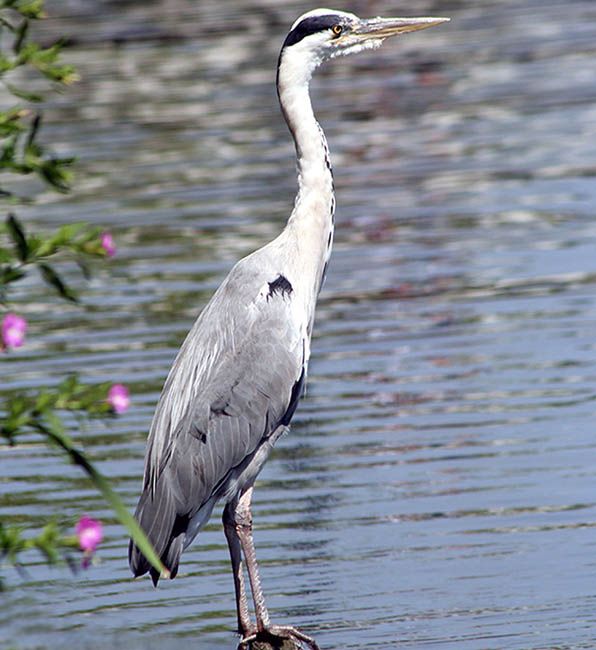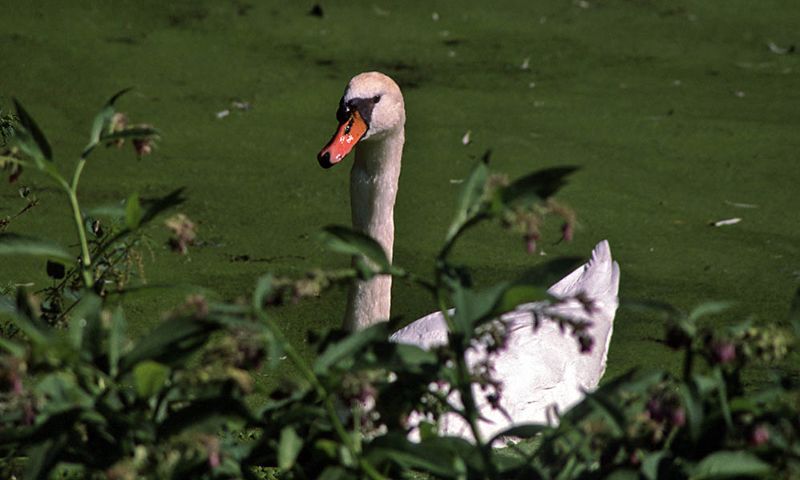Airone cenerino Ardea cinerea Linnaeus, 1758
- Uccello di grandi dimensioni con collo, becco e zampe molto lunghi, appartenente all'ordine dei Ciconiformi. Dimensioni. Lunghezza 90 cm, apertura alare 150-160 cm
. - Aspetto. Il maschio e la femmina sono indistinguibili e hanno una colorazione prevalentemente grigia con ampie aree bianche e nere. Sul capo degli adulti è presente un sottile ciuffo nero. I giovani hanno una colorazione più tenue, che all'aumentare dell'età si avvicina sempre di più a quella degli adulti. Nidificazione. Nidifica in colonie sugli alberi e nei canneti. In generale predilige le pianure, ma può vivere benissimo anche a 2000 metri sul livello del mare. Ama le zone umide d’acqua dolce, le cave d’argilla, le aree lagunari e le valli da pesca, nella maggior parte dei casi con ricca vegetazione ripariale, costituita da boschi di pioppo e salice. Un uccello da stagno è il cigno. Esso è un uccello di grande dimensione, infatti varia dai 155 ai 310 centimetri di apertura alare. Il cigno ha il collo molto lungo, zampe corte e palmate. La caratteristica dei cigni è il loro mutamento del piumaggio. Infatti, alla nascita hanno un colore rosa per poi passare ad grigio e infine al più classico bianco o nero. Vive in baie riparate, paludi aperte, laghi e stagni e, in inverno, non è raro vedere oltre 100 individui in specchi di acqua salata. Inoltre, con i loro 15 kg, sono fra gli uccelli più pesanti al mondo. I due sessi sono simili ma i maschi sono generalmente più grandi delle femmine.
Gray Heron Ardea cinerea Linnaeus, 1758 - Large bird with very long neck, beak and legs, belonging to the order of the Ciconiforms.Dimensions. Length 90 cm, wingspan 150-160 cm. - Appearance. The male and the female are indistinguishable and have a predominantly gray color with large white and black areas. On the head of adults there is a thin black tuft. Young people have a softer color, which as the age increases is getting closer and closer to that of adults. Nesting. It breeds in colonies on trees and reeds. In general it prefers the plains, but can live very well even at 2000 meters above sea level. He loves the freshwater wetlands, the clay pits, the lagoon areas and the fishing valleys, in most cases with rich riparian vegetation, consisting of poplar and willow woods. A pond bird is the swan. It is a bird of great size, in fact it varies from 155 to 310 centimeters of wingspan. The swan has a very long neck, short legs and webbed. The characteristic of the swans is their change in plumage. In fact, at birth they have a pink color and then go gray and finally the more classic white or black. It lives in sheltered bays, open bogs, lakes and ponds and, in winter, it is not uncommon to see over 100 individuals in saltwater mirrors. Moreover, with their 15 kg, they are among the heaviest birds in the world. The two sexes are similar but the males are generally larger than the females.









